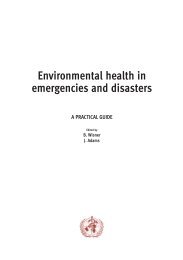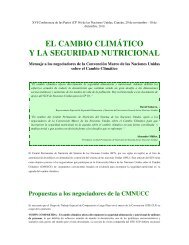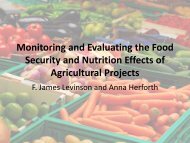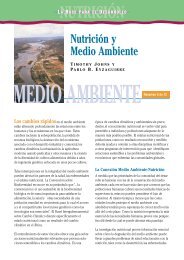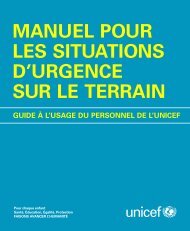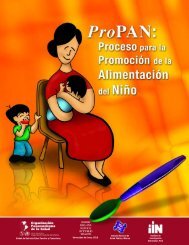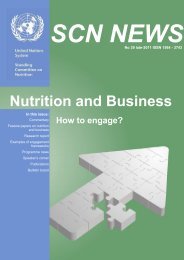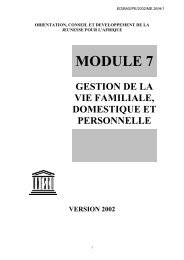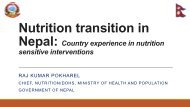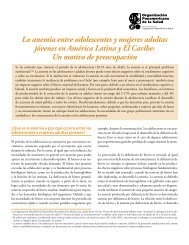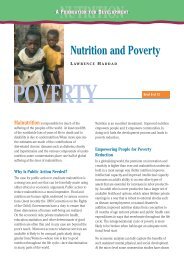SCN News No 36 - UNSCN
SCN News No 36 - UNSCN
SCN News No 36 - UNSCN
You also want an ePaper? Increase the reach of your titles
YUMPU automatically turns print PDFs into web optimized ePapers that Google loves.
www.unsystem.org/scn FEATURES 19<br />
Table 1 summarizes the various interventions with demonstrated impact on maternal and child undernutrition<br />
in all countries. These are interventions that have sufficient evidence to be implemented in all countries to<br />
improve maternal and birth outcomes and nutrition of newborns, infants and young children. Promotion of<br />
breastfeeding and complementary feeding comes out as a very important intervention, along with<br />
micronutrients provided in pregnancy and maternal protein-energy supplementation. Importantly, for each of<br />
the conditions contributing to nutrition-related disability and death there are already highly effective<br />
interventions available. Other interventions were found to be appropriate in certain situational contexts, such<br />
as in malaria endemic areas or areas with high deficiency rates of particular micronutrients.<br />
Modelling the impact of nutrition interventions<br />
For the purpose of modelling the effect of these interventions, we developed a cohort model with data from<br />
the <strong>36</strong> high burden countries. Taking into account existing intervention coverage, we calculated the potential<br />
effect of scaling-up the proven nutrition and health-related interventions to 70%, 90% and 99% to see how<br />
much additional disease burden (DALYs)<br />
Figure 1: Cohort model for mortality and stunting<br />
or mortality (deaths) could be averted. The<br />
used to model the effectiveness of interventions<br />
major aspect of the model is a cohort<br />
structure that follows children from birth to<br />
<strong>36</strong> months, with death, stunting and no<br />
stunting as potential outcomes. Figure 1<br />
shows the sort of information generated by<br />
the model and what happens between<br />
birth and <strong>36</strong> months of age. Starting at<br />
birth and then progressively looking over<br />
time, by <strong>36</strong> months of age about 9% of<br />
children have died (mortality showed in top<br />
part of figure) and of those who survive<br />
over half (58%) are stunted (stunting<br />
0 12 24 <strong>36</strong><br />
Age in months<br />
showed in middle part of figure). This<br />
Died<br />
Stunted<br />
cohort was mainly used for the preventive<br />
<strong>No</strong>t stunted<br />
interventions, whereas for the therapeutic<br />
treatment of severe acute malnutrition we<br />
modelled separately to calculate the<br />
Table 3: Reductions in child mortality at full coverage<br />
number of deaths that could be averted.<br />
Table 3 lists some of the results from the<br />
modelling. For reductions in child mortality at<br />
full coverage of the evidence-based<br />
interventions, breastfeeding promotion is<br />
expected to have high impact. The<br />
calculations are based on the best available<br />
evidence for how well breastfeeding<br />
promotion programmes have changed<br />
practices. Individual peer counselling, for<br />
example, has been rather successful in<br />
changing breastfeeding practices towards<br />
more exclusive breastfeeding.<br />
Supplementation with vitamin A and of zinc<br />
has important preventive effects on<br />
mortality. Complementary feeding promotion<br />
and supplementation in food insecure areas<br />
% of birth cohort<br />
0 20 40 60 80 100<br />
Child interventions<br />
• Breastfeeding promotion – 9.1%<br />
• Vitamin A supplementation – 7.2%<br />
• Zinc supplementation – 3.6%<br />
• Treatment of severe malnutrition – 2.2%<br />
• Comp. feeding promotion/supplement. – 1.5%<br />
Maternal interventions<br />
• Energy/protein supplementation – 2.9%<br />
• Intermittent preventive malaria treatment – 1.9%<br />
• Multiple micronutrients – 1.6%<br />
Table 4: Other intervention effects at full coverage<br />
• Zinc supplementation – 17% reduction in stunting<br />
• Complementary feeding promotion/supplementation– 15 % reduction<br />
in stunting<br />
• Iron and folate supplementation – 20% reduction in maternal<br />
deaths<br />
• Hygiene promotion – 2.4% reduction in stunting<br />
back to contents <strong>SCN</strong> NEWS # <strong>36</strong>




